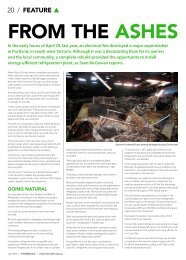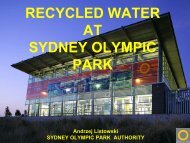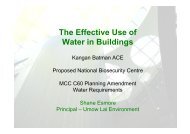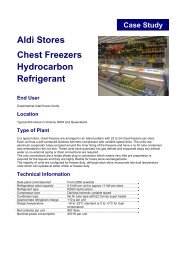Tenability criteria for design of smoke hazard management ... - Airah
Tenability criteria for design of smoke hazard management ... - Airah
Tenability criteria for design of smoke hazard management ... - Airah
You also want an ePaper? Increase the reach of your titles
YUMPU automatically turns print PDFs into web optimized ePapers that Google loves.
34<br />
FORUM<br />
that the limits are higher with the protection <strong>of</strong> clothing. For<br />
example, field tests [8] were conducted where the author, with<br />
the protection <strong>of</strong> light clothing, exposed himself to radiant heat<br />
flux <strong>of</strong> 5.0 kW/m 2 <strong>for</strong> 30 s without suffering skin pain or burns.<br />
toxic gases<br />
In building fires, the most common asphyxiate is carbon<br />
monoxide (CO) and, to a lesser extent, hydrogen cyanide<br />
(CHN) which is more toxic. The exposure limits that cause<br />
incapacitation depend on the gas species, concentrations and<br />
durations <strong>of</strong> exposure. They were obtained from tests [7, 20]<br />
conducted on primates (juvenile baboons and cynomolgus<br />
monkeys) by subjecting them to various concentrations <strong>of</strong> CO<br />
and HCN. The results are shown Figure 4.<br />
eColibRiuM • Augu St 2011<br />
Figure 4: Tolerance to CO and HCN<br />
It is assumed that these limits are the same <strong>for</strong> humans.<br />
Loss <strong>of</strong> consciousness may also occur due to hypoxia at<br />
oxygen levels lower than 12%; or due to narcotic effects at<br />
carbon dioxide levels higher than 6%. However, it is considered<br />
that these conditions are unlikely to occur in building fire<br />
conditions [9, 10].<br />
Smoke obscuration<br />
Soot contained in <strong>smoke</strong> also obscures light and hence reduces<br />
visibility. Reduction in visibility is not directly life threatening<br />
such as heat or toxic gas exposure; however, it may reduce the<br />
walking speed <strong>of</strong> the occupants [11].<br />
Combustion gases in the <strong>smoke</strong> may also cause irritation<br />
to the eyes. These include acid gases (HF, HCl, HBr, SO2, NOx) and organic irritant gases (acrolein, <strong>for</strong>maldehyde, crotonaldehyde).<br />
Their effects have a similar effect to reduced visibility (see Figure 5).<br />
If the occupants are located at a significant distance from<br />
an exit and the visibility drops significantly, they may be unable<br />
to find their way out <strong>of</strong> the building. In either case, it may lead to<br />
an increased exposure time to heat and toxic gases which needs<br />
to be taken into account.<br />
deSigN APPRoACHeS<br />
Generally speaking, there are two main approaches to the <strong>design</strong><br />
<strong>of</strong> <strong>smoke</strong> <strong>hazard</strong> <strong>management</strong> systems. These are discussed below.<br />
No <strong>smoke</strong> exposure<br />
The first approach is to ensure that the occupants are not<br />
directly exposed to <strong>smoke</strong> — by keeping the <strong>smoke</strong> layer above<br />
the head height <strong>of</strong> the occupants. This height may be assumed<br />
to be 2.0m above the floor level, noting that the average heights<br />
<strong>of</strong> Australian adult males and females are 1.78m and 1.64m<br />
respectively [12]. This approach may be achieved by means<br />
<strong>of</strong> <strong>smoke</strong> exhaust, <strong>smoke</strong> venting, <strong>smoke</strong> containment or<br />
by ensuring that the occupants can quickly move out <strong>of</strong> the<br />
building (see Figure 6).<br />
Figure 6: Occupants not Exposed to Smoke<br />
The <strong>smoke</strong> exhaust systems prescribed by BCA Specification<br />
E2.2b are based on this approach, which requires the <strong>smoke</strong> layer<br />
to be maintained not less than 2.0m above the floor level.<br />
Smoke exposure<br />
In the second approach, it is assumed in the <strong>design</strong> that some<br />
<strong>of</strong> the occupants may need to move through tenable <strong>smoke</strong><br />
environments to evacuate the building (see Figure 7).<br />
teNAbility CRiteRiA<br />
Figure 5: Walking Speed versus Visibility<br />
Figure 7: Occupants Exposed to Smoke<br />
Irrespective <strong>of</strong> the <strong>design</strong> approach, the <strong>smoke</strong> <strong>hazard</strong><br />
<strong>management</strong> system must be evaluated against a set <strong>of</strong> <strong>criteria</strong> to<br />
ensure safe evacuation <strong>of</strong> the occupants. This may be achieved by<br />
assuming a <strong>design</strong> fire and analysing the fire environments and<br />
occupant evacuation. The fire environments may be analysed<br />
using zone models such as CFAST [12] or computational fluid







